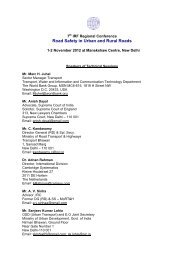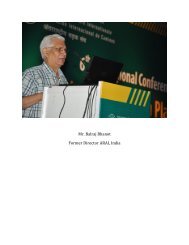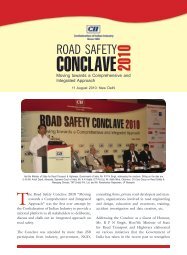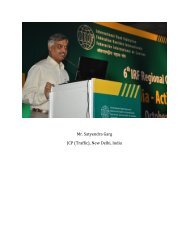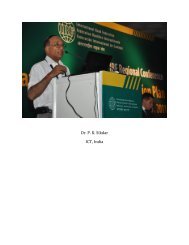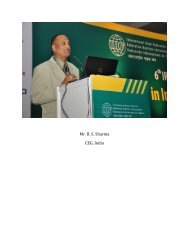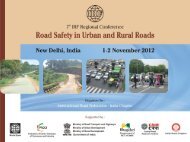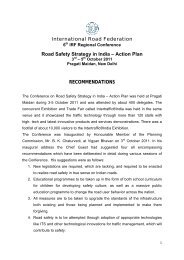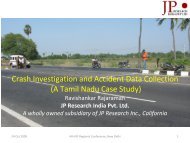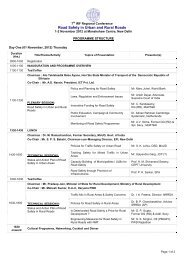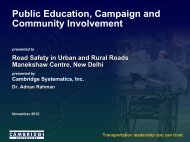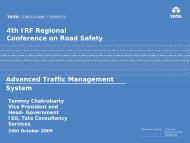Dr. B. P. Chandrasekhar, Advisor SRRDA (AP) - Road Safety in ...
Dr. B. P. Chandrasekhar, Advisor SRRDA (AP) - Road Safety in ...
Dr. B. P. Chandrasekhar, Advisor SRRDA (AP) - Road Safety in ...
Create successful ePaper yourself
Turn your PDF publications into a flip-book with our unique Google optimized e-Paper software.
Policy for <strong>Road</strong> <strong>Safety</strong> <strong>in</strong> Rural <strong>Road</strong>s<br />
Prof. B.P. <strong>Chandrasekhar</strong><br />
Technical <strong>Advisor</strong>, <strong>AP</strong><strong>SRRDA</strong>, Go<strong>AP</strong><br />
Formerly, Director(Tech),NRRDA, MoRD,<br />
GoI<br />
E‐mail: sekharbpc@gmail.com
Need for <strong>Road</strong> safety Management<br />
<strong>Road</strong> accidents are mount<strong>in</strong>g year after year becom<strong>in</strong>g a<br />
cause of concern to all stake holders.<br />
Recently available data reveals that an estimated 1.3 million<br />
people are killed around the globe and another 50 million are<br />
<strong>in</strong>jured <strong>in</strong> road accidents. Many of those <strong>in</strong>volved <strong>in</strong> serious<br />
accidents rema<strong>in</strong> disabled for life and become liability to their<br />
families.<br />
<strong>Road</strong> accidents are the major cause of death of young people<br />
<strong>in</strong> the age group 15‐29 years.<br />
The global f<strong>in</strong>ancial cost of road traffic <strong>in</strong>juries works out to<br />
US$ 518 billion<br />
Low and middle <strong>in</strong>come countries account for 85% of globle<br />
deaths from road traffic crashes.<br />
In India about 41% of the fatalities are pedestrians, cyclists and<br />
two wheeler riders.
Causative Factors for the Accidents<br />
<strong>Road</strong><br />
<strong>Road</strong> user<br />
Vehicle<br />
Environment<br />
Literature <strong>in</strong>dicates that 65‐75 % of the road<br />
accidents are due to HUMAN Error.<br />
Hence, the target to the action plan for m<strong>in</strong>imis<strong>in</strong>g<br />
accident is the ROAD USER mostly.
Commonly Known Reasons<br />
o Ignorance of Traffic Rules <strong>in</strong> driv<strong>in</strong>g.<br />
o Not be<strong>in</strong>g tra<strong>in</strong>ed scientifically.<br />
o Intolerance and short temper.<br />
o Lack of awareness to deal with<br />
situations that arise suddenly <strong>in</strong> the<br />
traffic steam.<br />
o Attitude for rule break<strong>in</strong>g rather than<br />
adher<strong>in</strong>g to rules of the road.
Accident Prevention Strategy
Characteristics Traffic on Rural <strong>Road</strong>s<br />
Normally the traffic com<strong>in</strong>g on to the rural roads is<br />
either generated traffic or converted traffic.<br />
<strong>Dr</strong>ivers and other road users lack exposure and<br />
awareness of rules and regulations or dangers<br />
associated with traffic movement.<br />
When rural roads are directly connected to NH or SH,<br />
the drivers are ignorant about merg<strong>in</strong>g and diverg<strong>in</strong>g<br />
process, <strong>in</strong>creas<strong>in</strong>g the risk of accident occurrence.<br />
Many a time the drivers are not formally tra<strong>in</strong>ed .<br />
The traffic composition differs from that of other<br />
higher order roads
Rural <strong>Road</strong>s <strong>Safety</strong> Concerns<br />
S<strong>in</strong>ce Rural <strong>Road</strong>s are generally carry low<br />
volumes of traffic and accident rates are<br />
presently low, <strong>Safety</strong> issues ma<strong>in</strong>ly are with<br />
respect to the Design and Construction features.<br />
Further, <strong>Road</strong> <strong>Safety</strong> consciousness of local<br />
residents become essential
Eng<strong>in</strong>eer<strong>in</strong>g Measures<br />
Alignment Design with due consideration to<br />
the terra<strong>in</strong>, obligatory po<strong>in</strong>ts and the design<br />
speed.<br />
Exam<strong>in</strong>e the constra<strong>in</strong>ts, if any and adjust the<br />
design, provid<strong>in</strong>g the required <strong>in</strong>formation to<br />
the road users.<br />
Provid<strong>in</strong>g necessary road furniture for guid<strong>in</strong>g<br />
the traffic<br />
Recheck<strong>in</strong>g the geometrics before ground<strong>in</strong>g<br />
the work
Eng<strong>in</strong>eer<strong>in</strong>g Measures ( cond.. )<br />
Check<strong>in</strong>g the geometrics at each stage of work<br />
process.<br />
Prepar<strong>in</strong>g alternate designs, if unforeseen<br />
ground conditions are encountered dur<strong>in</strong>g<br />
construction <strong>in</strong> any particular stretch.<br />
Cont<strong>in</strong>ue construction as per the design with<br />
frequent checks.<br />
Carryout trail runs on the new facility before<br />
open<strong>in</strong>g to the regular traffic.
The Strategy adopted <strong>in</strong> PMGSY<br />
DPRs are prepared as per a specially designed template with<br />
the follow<strong>in</strong>g detail<strong>in</strong>g keep<strong>in</strong>g safety as a primary parameter<br />
•Plann<strong>in</strong>g and basic design considerations captur<strong>in</strong>g the<br />
<strong>in</strong>ventory details along a strip, not<strong>in</strong>g the features on either side<br />
of the centre l<strong>in</strong>e of the proposed road. Digital photographs<br />
taken for every 100m and further at any special feature like a<br />
junction, culvert, curves etc. This is followed by com<strong>in</strong>g with<br />
prelim<strong>in</strong>ary design proposals that would require data to be<br />
collected dur<strong>in</strong>g the <strong>in</strong>vestigations.<br />
•Def<strong>in</strong><strong>in</strong>g the design speed and associated geometric parameters<br />
.<br />
•Alignment design cover<strong>in</strong>g all parameters <strong>in</strong> the horizontal and<br />
vertical planes.
Strategy adopted <strong>in</strong> PMGSY(Contd)<br />
Traffic <strong>Safety</strong> and management issues are given special<br />
emphasis for design<strong>in</strong>g a safe road. Particular attention is<br />
given to design of junctions and curves.<br />
Environmental concerns are taken note of and attended to.<br />
DPRs ,thus prepared are subjected to series of checks by the<br />
senior officers of the Execut<strong>in</strong>g Agency before forward<strong>in</strong>g<br />
them to an Independent Third Party Audit ie State Technical<br />
Agency (STA).<br />
The STAs, normally reputed Eng<strong>in</strong>eer<strong>in</strong>g Institutions, check<br />
the DPRs for optimal design, appropriate provisions,<br />
<strong>in</strong>clud<strong>in</strong>g the safety requirements of the road and approve<br />
the DPRs on‐l<strong>in</strong>e<br />
THIS PROCESS ENSURES SAFETY ON THE PROPOSED RURAL<br />
ROAD , INCLUDING THE SAFETY AUDIT AT THE DESIGN<br />
STAGE
Strategy adopted <strong>in</strong> PMGSY<br />
<strong>Safety</strong> Audit Dur<strong>in</strong>g Construction<br />
Dur<strong>in</strong>g the progress of construction, the First and Second Tiers of<br />
Quality Management System of PMGSY ensure that the design and<br />
provisions made <strong>in</strong> the DPR are translated on to the ground. In case<br />
any deficiency is noticed, immediate corrective measures are taken and<br />
thus <strong>Safety</strong> is ensured.<br />
Dur<strong>in</strong>g construction stage it self , Independent third party<br />
eng<strong>in</strong>eers viz National Quality Monitors ( NQMs ) <strong>in</strong>spect the road and<br />
exam<strong>in</strong>e all the elements and provisions. If any deficiency is noticed,<br />
they give them on the spot <strong>in</strong> writ<strong>in</strong>g . Based on the observations, the<br />
executive agency has to give an Action Taken Report (ATR) duly<br />
attend<strong>in</strong>g to the observations and the rectifications carried out to get a<br />
satisfactory grade for the work.<br />
Thus, Traffic <strong>Safety</strong> is ensured wrt. Eng<strong>in</strong>eer<strong>in</strong>g Measures under<br />
PMGSY
Rural <strong>Road</strong> <strong>Safety</strong>‐ provisions <strong>in</strong> the<br />
PMGSY Guidel<strong>in</strong>es<br />
• At the central level safety issues will be addressed<br />
through coord<strong>in</strong>ation with ROAD SAFETY MISSION of<br />
MoRT&H.<br />
• At the state, the State Quality Coord<strong>in</strong>ator (SQC) at<br />
<strong>SRRDA</strong> level and DPIU at the District level shall be<br />
tasked by the State Govt. to coord<strong>in</strong>ate with State<br />
Level <strong>Road</strong> <strong>Safety</strong> mechanisms and programs, <strong>in</strong><br />
particular through membership of the State <strong>Road</strong><br />
<strong>Safety</strong> Council and District <strong>Road</strong> safety Committees<br />
respectively, created as per the provisions of<br />
section215 of the MV act,1988.
Provisions <strong>in</strong> the PMGSY Guidel<strong>in</strong>es (Contd)<br />
As a part of Rural <strong>Road</strong>s Development and ma<strong>in</strong>tenance<br />
programs , the State Govts. shall ensure ROAD SAFETY<br />
AUDIT of PMGSY works along with Quality monitor<strong>in</strong>g. It<br />
shall also ensure adequate <strong>in</strong>volvement of Panchayat<br />
Raj Institutions <strong>in</strong> road safety Awareness Programs.<br />
Awareness rais<strong>in</strong>g activities, <strong>in</strong>clud<strong>in</strong>g publication of<br />
pamphlets, Audio‐Visuals, Interactive Programs etc. will<br />
be funded on the basis of annual proposals to be<br />
forwarded for the clearance of the Empowered<br />
Committee, along with road proposals.
Thank You
Eng<strong>in</strong>eer<strong>in</strong>g Measures <strong>in</strong> Design Phase<br />
• Rural roads have to necessarily have a tortuous path, keep<strong>in</strong>g <strong>in</strong><br />
view the narrow land width available. All the same, the horizontal<br />
curves should be designed scientifically, conform<strong>in</strong>g to the selected<br />
design speed and terra<strong>in</strong>. The horizontal curves must be provided<br />
with smooth transition curves and super‐elevation. The pavements<br />
should be widened at curves.<br />
• The vertical profile of the road should be designed such that the<br />
required m<strong>in</strong>imum stopp<strong>in</strong>g sight distance is available. Suitable<br />
summit and valley curves should be provided.<br />
• In hill roads, bl<strong>in</strong>d curves are a safety hazard. Suitable vision berms<br />
may be cut at such locations.<br />
• Pass<strong>in</strong>g places must be provided at convenient locations particularly<br />
on hill roads.<br />
• The provision of rural connectivity leads to the <strong>in</strong>troduction of bus<br />
services. Properly designed bus‐bays must be provided at bus stop<br />
to ensure that the buses do not hamper the normal traffic.
Eng<strong>in</strong>eer<strong>in</strong>g Measures <strong>in</strong> Design Phase (Cont..)<br />
• Where the roads pass through habitations and school, it is<br />
necessary that the motorized vehicles travel at low speeds. This<br />
can be ensured by provid<strong>in</strong>g adequately designed road humps or<br />
rumble strips.<br />
• The junction of rural roads with a ma<strong>in</strong> road is always a po<strong>in</strong>t of<br />
conflict and an accident‐prone zone. Such junctions must be<br />
designed scientifically by provid<strong>in</strong>g m<strong>in</strong>imum turn<strong>in</strong>g radii, flar<strong>in</strong>g<br />
of the side road with taper, acceleration/deceleration lanes and<br />
adequate sight distances.<br />
• Ramps must be provided where field paths and cattle cross<strong>in</strong>gs<br />
<strong>in</strong>tersect the road.<br />
• Traffic signages, <strong>in</strong>corporat<strong>in</strong>g warn<strong>in</strong>g and regulatory signs, can<br />
enhance road safety, especially near habitations and school zones,<br />
sharp curves, narrow bridges, junctions, submersible bridges and<br />
causeways. The design must <strong>in</strong>corporate these.
Eng<strong>in</strong>eer<strong>in</strong>g Measures <strong>in</strong> Design Phase (Cont..)<br />
• Hazard markers like reflectorised del<strong>in</strong>eaters must be<br />
provided at dangerous locations.<br />
• Submersible bridges and causeways should be provided<br />
with water depth gauges and guide‐posts that shall<br />
rema<strong>in</strong> at all times above the highest water level.<br />
• 300mm dia ducts should be provided <strong>in</strong> the<br />
embankment to enable cultivators to thread agricultural<br />
wise pipes for irrigat<strong>in</strong>g their fields ly<strong>in</strong>g on both sides<br />
of the road.
<strong>Safety</strong> Dur<strong>in</strong>g Construction Or<br />
Ma<strong>in</strong>tenance Operation<br />
Construction zones create an environment where the road<br />
user is confronted with sudden obstacles and unfamiliar<br />
conditions. <strong>Safety</strong> <strong>in</strong> construction zones must be enhanced<br />
by:<br />
•Warn<strong>in</strong>g the road users (<strong>in</strong> the appropriate language)<br />
clearly and sufficiently <strong>in</strong> advance<br />
•Provid<strong>in</strong>g safe and clearly marked lanes for guid<strong>in</strong>g road<br />
users<br />
•Provid<strong>in</strong>g safe and clearly marked buffer zones and work<br />
zones<br />
o Barricades, drums, traffic cones, cyl<strong>in</strong>ders and signs around<br />
work zones
<strong>Safety</strong> Dur<strong>in</strong>g Construction Or<br />
Ma<strong>in</strong>tenance Operation (Cont…)<br />
o Flagmen with red flags positioned to regulate and warn the road<br />
users.<br />
o Us<strong>in</strong>g construction mach<strong>in</strong>ery carefully and park<strong>in</strong>g such<br />
mach<strong>in</strong>ery at locations where they are not traffic hazards.<br />
o Stack<strong>in</strong>g construction materials such that only the quantity<br />
needed for one operation is stacked along the road, and<br />
obstruction to road users is m<strong>in</strong>imized.<br />
o Provid<strong>in</strong>g well designed temporary diversions as necessary so<br />
that the essential traffic moves with the least h<strong>in</strong>drance. The<br />
Contractor shall be asked to provide these as part of his work.<br />
The bidd<strong>in</strong>g document and specifications shall elaborate these<br />
requirements.
<strong>Road</strong> <strong>Safety</strong> Dur<strong>in</strong>g Use<br />
The Head of PIU will be the District Rural <strong>Road</strong>s <strong>Safety</strong> Officer (DRRSO).<br />
To ensure operational safety the DRRSO shall ensure that<br />
•Rout<strong>in</strong>e ma<strong>in</strong>tenance of rural roads are regularly carried out.<br />
•All safety issues out of ma<strong>in</strong>tenance <strong>in</strong>spection are properly addressed.<br />
•In all cases of accidents and <strong>in</strong>quiry/<strong>in</strong>vestigation thereof, safety issues<br />
are resolved, and a report is made to the SQC for exam<strong>in</strong>ation whether<br />
standard design features need to be <strong>in</strong>corporated <strong>in</strong> other rural roads.<br />
•All resolutions of Panchayats regard<strong>in</strong>g safety issues are acknowledged<br />
and action proposed/taken <strong>in</strong>timated to the Panchayat.<br />
•<strong>Road</strong> safety awareness camps are organised <strong>in</strong>volv<strong>in</strong>g Panchayats, School,<br />
Rural road users (<strong>in</strong>habitants as well as drivers), <strong>in</strong> accordance with<br />
programmes drawn up by the State Quality Coord<strong>in</strong>ator.
<strong>Road</strong> <strong>Safety</strong> Dur<strong>in</strong>g Use (Cont..)<br />
The State Quality Coord<strong>in</strong>ator will be the State Rural <strong>Road</strong><br />
<strong>Safety</strong> Officer and shall ensure:<br />
•Adequate coord<strong>in</strong>ation with the State <strong>Road</strong> <strong>Safety</strong> Council<br />
and road safety programmes.<br />
•Formulation of rural road safety awareness programme<br />
proposals (for fund<strong>in</strong>g under PMGSY).<br />
•Implementation and coord<strong>in</strong>ation of rural road safety<br />
awareness programmes <strong>in</strong> the field.<br />
•Hold quarterly meet<strong>in</strong>g with DRRSO and take feedback for<br />
improv<strong>in</strong>g safety standards.



